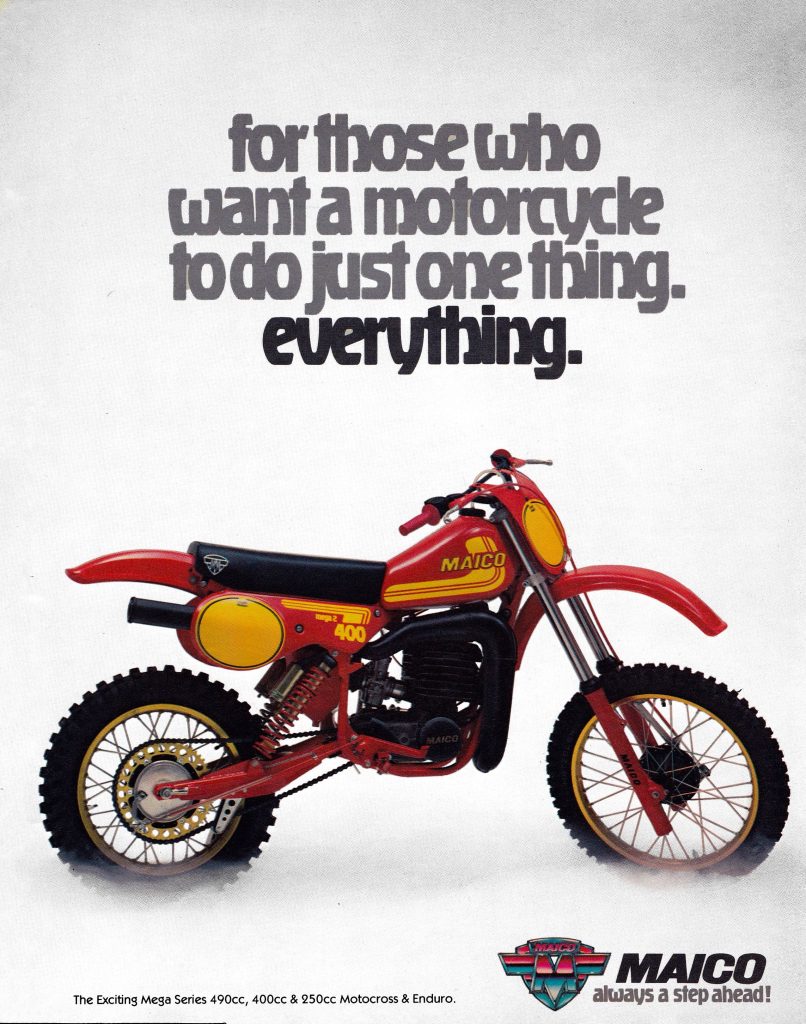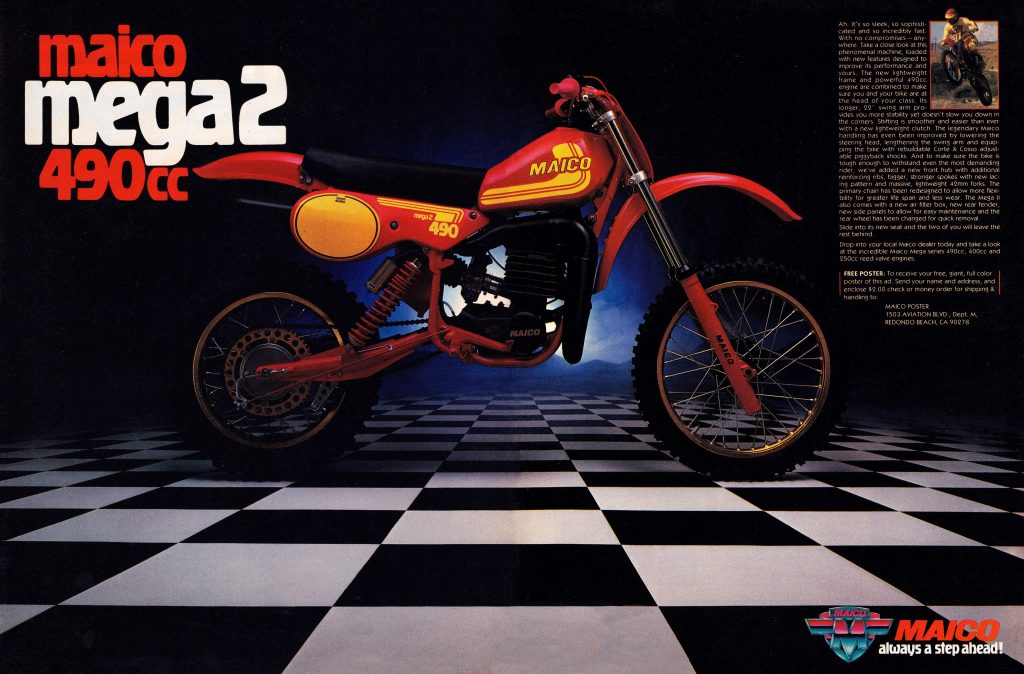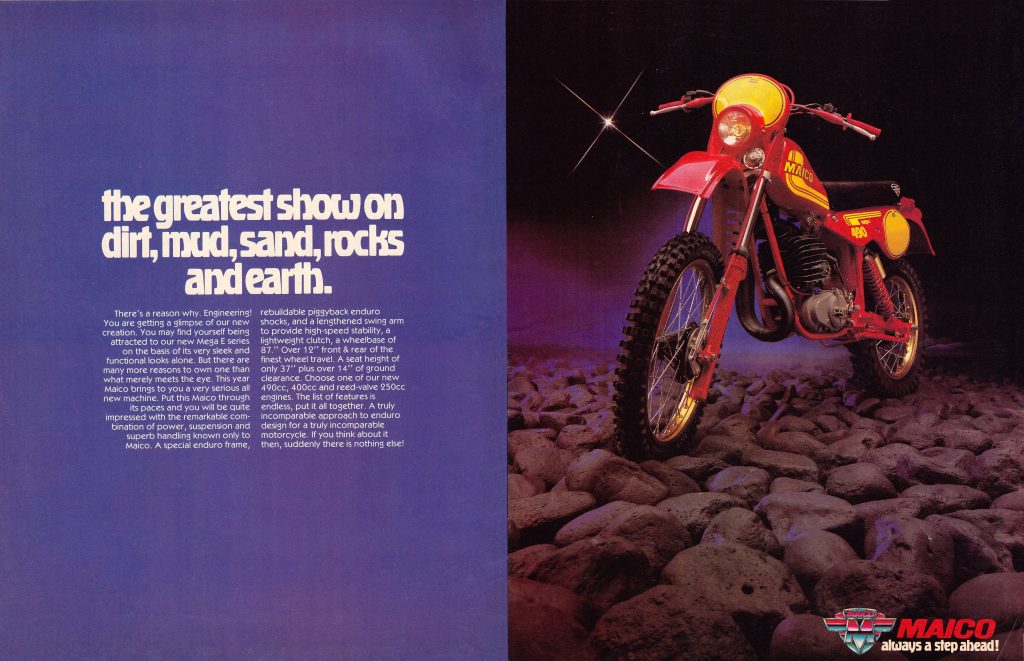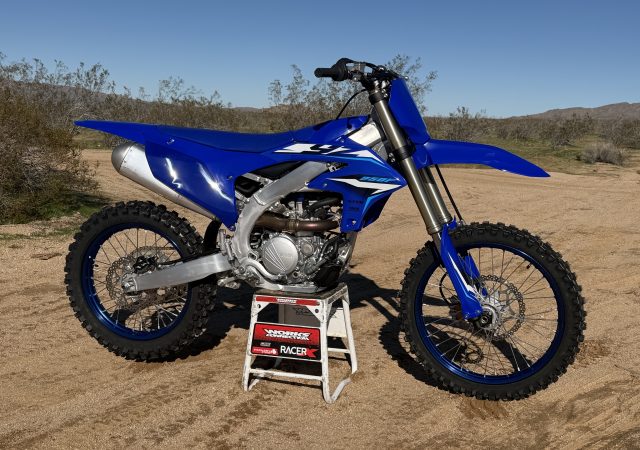
For this edition of Classic Ink, we are going to look back at an ad for one of the most iconic motocross machines of the 1980s, Maico’s 1981 490 Mega 2.
 The all-new Maico MC490 Mega 2 hit the market in 1981 and took the 500 class by storm. Despite its dual shocks and low-tech motor, the mighty Maico outsold Honda’s entire ’81 motocross lineup combined.
The all-new Maico MC490 Mega 2 hit the market in 1981 and took the 500 class by storm. Despite its dual shocks and low-tech motor, the mighty Maico outsold Honda’s entire ’81 motocross lineup combined.
In 1981, Maico released a machine that many even today revere as one of the greatest motocross bikes ever built – the mighty MC490 Mega 2. At the time of the Mega 2’s introduction, the European motocross brands were under tremendous commercial pressure from the Japanese. Once the most dominant marques in motocross, Old World manufacturers like Husqvarna, CZ, BSA, and Maico found it difficult to keep up with the innovative and efficient Japanese. The Japanese bikes were not always the best performers, but they were reliable, well-built, and supported by a superior network of dealers. Within ten years, the Japanese went from a motocross curiosity to acknowledged leaders in the sport.
While the Japanese dominated the 125 and 250 divisions, they faced much steeper competition in the big-bore classes. Excellent machines from Maico and Husqvarna remained competitive against the Japanese and offered a very different flavor of big-bore performance. Open bike excellence is often more about power quality than power quantity, and in the late seventies and early eighties the Europeans had that down to a science.
 Maico offered a full range of Mega 2 machines in 1981 but the 490 was the crown jewel of the lineup.
Maico offered a full range of Mega 2 machines in 1981 but the 490 was the crown jewel of the lineup.
As 1981 arrived, the 500 class heated up even further with the arrival of Honda’s hugely anticipated first Open bike, the CR450R. The addition of the Honda big-bore completed the complement of Big Four Japanese entries in the division. At the time, Yamaha’s YZ465 was the reigning king of the Nipponese entries with its blisteringly fast 465cc motor. All four of the Japanese bikes offered monoshock suspensions, with the Honda, Kawasaki, and Suzuki all employing the very latest linkage designs to smooth out the track. None of the machines in the Open class featured liquid cooling, but all four of the Japanese bikes featured reed valves for their intakes and advanced electronic ignitions for reliable operation.
Compared to the high-tech goodies found on the Japanese bikes, Maico’s all-new 490 Mega 2 seemed positively rudimentary. It continued to use a set of dual Corte Cossa shocks to handle the rear suspension duties and employed a massive 488cc piston-port single cylinder two stroke for motivation. This gave it a displacement advantage over its Japanese competitors but with its 40mm Bing carburetor and no reed valve, it lacked the “right now” response of some of its rivals.
Thankfully, this did not turn out to be an issue for the majority of big-bore pilots that threw a leg over the Mega 2 in 1981. The new 488cc mill cranked out a healthy 47.2 horsepower and ground-pounding 44.4-foot pounds of torque. This was four more horsepower than the leader of the Japanese contingent, the YZ465, put to the ground in 1981. While this horsepower number is not particularly impressive by today’s standards, the Maico’s massive 44.4 foot-pounds of torque dwarf the twist delivered even by modern fuel-injected 450s.
Even more impressive is how the German put all that power to the ground. Instead of spooling up quickly and exploding in a flurry of acceleration like Honda’s CR450R, the Maico metered out its power in a smooth flow of torque that hooked up and propelled the Maico forward at quasar speeds. There was no massive hit to fear or dip in the powerband to avoid. It just went when you twisted the throttle and kept going faster the longer you held it on. In 1981, riders loved the power the Maico put out and it remains a very fast machine even today.
 If you were more of the off-road type, you could enjoy the German’s luscious vibes on Maico’s 490 Mega E Enduro.
If you were more of the off-road type, you could enjoy the German’s luscious vibes on Maico’s 490 Mega E Enduro.
While the powerband was rated perfection, the Mega 2’s suspension remained a significant handicap. Neither the forks nor the shock was rated very well, and most hard-core racers felt the shocks and maybe even the swingarm needed to be replaced to get the most out of the Maico’s potential. Of course, with the Mega 2 costing 20% more than the Japanese machines in 1981, this could be a tough pill to swallow, but for serious racers, the money was well spent.
Today, the 1981 Maico Mega 2 remains an icon of 1980s motocross history. Big, beautiful, and more than a bit flawed, the Teutonic Tractor turned out to be the last gasp for Germany’s premier motocross manufacturer. Within a few years, Maico would be bankrupt, and the Japanese would complete their stranglehold of the motocross market by introducing a Mega 2 beater of their own, the awesome CR480R. Eventually, KTM would bring Europe back to motocross prominence, but for 40 years, the mighty 490 Mega 2 stood as the pinnacle of Old World motocross success.



